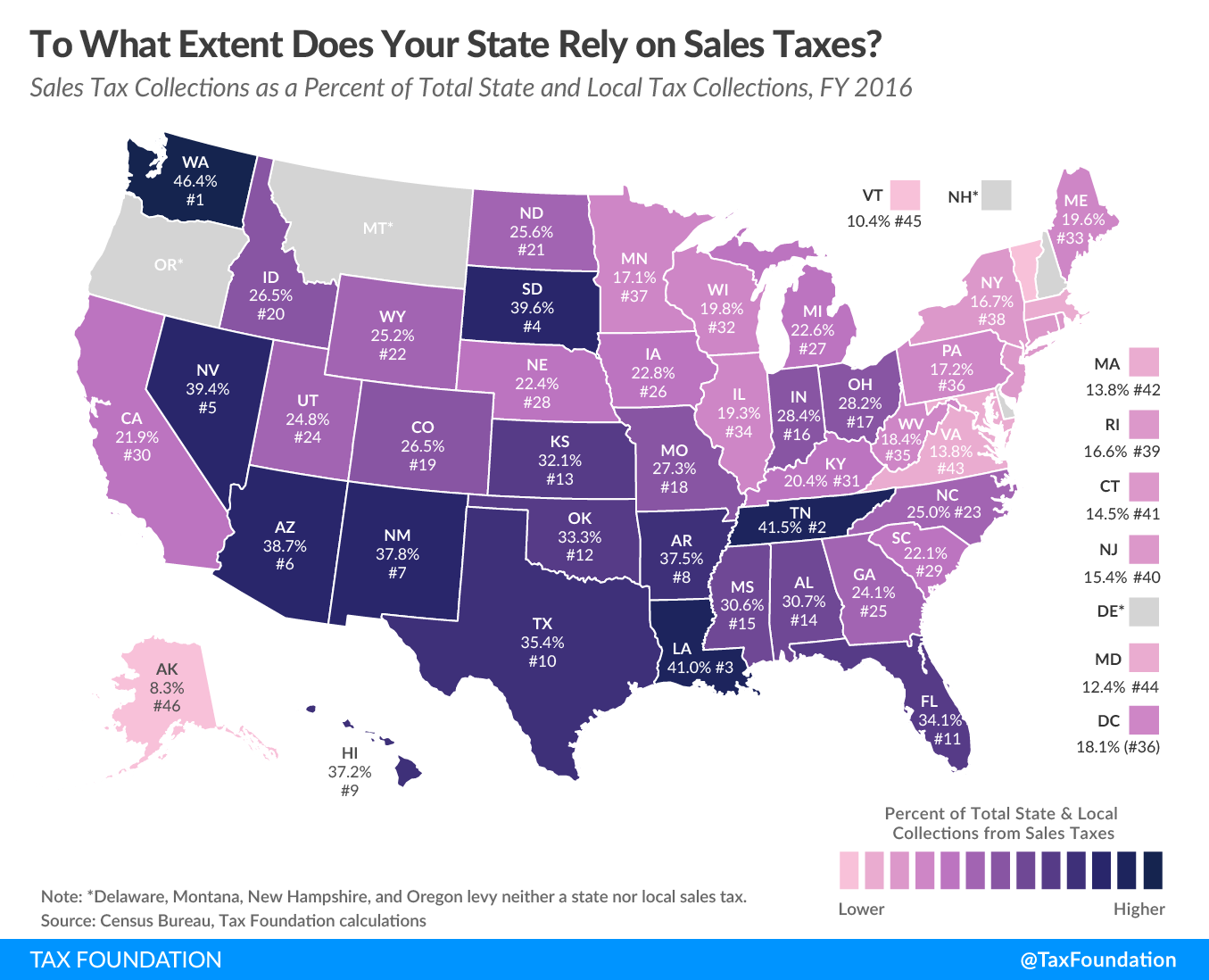Sales taxes are the second largest source of state and local taxA tax is a mandatory payment or charge collected by local, state, and national governments from individuals or businesses to cover the costs of general government services, goods, and activities. revenue, accounting for 23.6 percent of total U.S. state and local tax collections in fiscal year 2016 (the latest data available; see Facts & Figures Table 8). Only property taxes are a greater source of state and local tax revenue.
Sales taxes are consumption taxes, which are more economically neutral than taxes on capital and income. The reason stems from a commonsense principle: if you tax something, you get less of it. Sales taxes target only current consumption, while income taxes hit both present consumption and future consumption, because they fall on earnings that would either be used for either immediate consumption or saved for future consumption. When the income tax falls on earnings that would be used for future consumption, it also functions as a tax on investment because consumption deferred to the future is paid for with current savings.
While 45 states levy a statewide sales taxA sales tax is levied on retail sales of goods and services and, ideally, should apply to all final consumption with few exemptions. Many governments exempt goods like groceries; base broadening, such as including groceries, could keep rates lower. A sales tax should exempt business-to-business transactions which, when taxed, cause tax pyramiding. and 38 allow localities to collect separate sales taxes, four states levy neither a state nor a local sales tax: Delaware, Montana, New Hampshire, and Oregon (see Facts & Figures Table 19). Meanwhile, eight states levy a sales tax at the state, but not the local, level: Connecticut, Indiana, Kentucky, Maine, Maryland, Massachusetts, Michigan, and Rhode Island. Alaska is the only state that collects local, but not state, sales taxes.
Today’s map shows the extent to which sales taxes are responsible for tax revenue generation in each state. Washington—which has neither a corporate nor an individual income taxAn individual income tax (or personal income tax) is levied on the wages, salaries, investments, or other forms of income an individual or household earns. The U.S. imposes a progressive income tax where rates increase with income. The Federal Income Tax was established in 1913 with the ratification of the 16th Amendment. Though barely 100 years old, individual income taxes are the largest source of tax revenue in the U.S. but levies a harmful gross receipts tax on businesses—relies the most on sales tax revenue, which accounts for 46.4 percent of its total tax collections. Tennessee, which does not tax wage income and will fully repeal its tax on investment income by 2021, has the second-highest reliance on sales taxes at 41.5 percent of state and local tax collections. Louisiana is the third-most reliant on sales tax revenue, with 41.0 percent of tax collections attributable to sales taxes. South Dakota, which does not collect corporate or individual income taxes, is next with 39.6 percent.
Stay informed on the tax policies impacting you.
Subscribe to get insights from our trusted experts delivered straight to your inbox.
SubscribeAlthough Washington, Tennessee, South Dakota, and Nevada (39.4 percent) all rely heavily on the sales tax, they are not high-tax states. All four states forgo an individual income tax and choose to raise a large portion of their revenue through the sales tax instead. South Dakota additionally forgoes corporate income taxes. Wyoming does not levy individual or corporate income taxes either but manages to land near the middle of the pack in terms of sales tax reliance due to its heavy reliance on severance tax collections. This trade-off can be a good thing, as it allows the states to rely on consumption taxes, rather than the less economically neutral individual income tax. The most neutral form of sales tax would tax the final consumption of both goods and services at a low rate, while exempting business inputs.
Many factors can affect sales tax reliance. States and localities that border low-sales tax or no-sales tax jurisdictions often struggle to levy sales taxes with high rates, as these could prompt consumers to shop across the border.
Another consideration is the tax baseThe tax base is the total amount of income, property, assets, consumption, transactions, or other economic activity subject to taxation by a tax authority. A narrow tax base is non-neutral and inefficient. A broad tax base reduces tax administration costs and allows more revenue to be raised at lower rates. , the transactions that are subject to the sales tax. Public finance experts generally argue that a sales tax should apply to all final consumption, both goods and services. In practice, though, many states fall short of this ideal due to historical accident or policy decisions to exempt certain classes of goods
It is worth watching to see how the U.S Supreme Court’s recent decision in South Dakota vs. Wayfair will impact state reliance on sales taxes. The Court’s decision that states may subject online purchases to sales tax will broaden state sales tax bases. Still, many states see a significant narrowing of their bases as lawmakers continue to carve out exemptions, and as consumption patterns shift ever more towards relatively-untaxed services. In order to maintain a sales tax that acts as a stable and neutral source of revenue, the best solution continues to be to tax all final consumption at one low rate.
Note: This is part of a map series in which we examine the primary sources of state and local tax collections.
Stay informed on the tax policies impacting you.
Subscribe to get insights from our trusted experts delivered straight to your inbox.
Subscribe